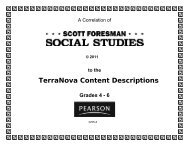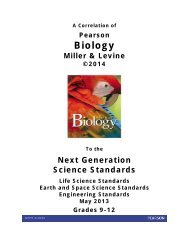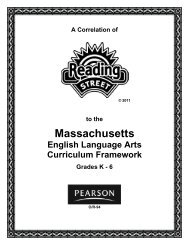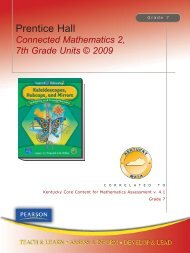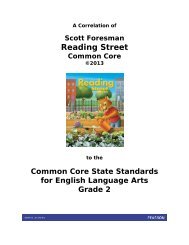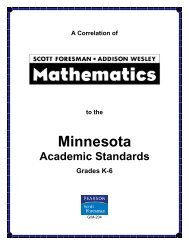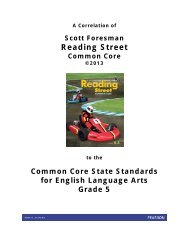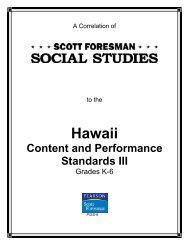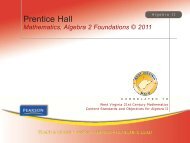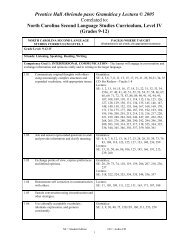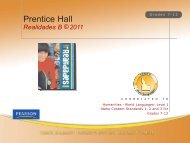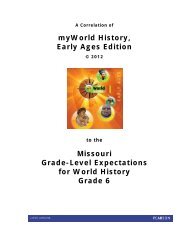Miller & Levine Biology: Foundation Edition - Pearson
Miller & Levine Biology: Foundation Edition - Pearson
Miller & Levine Biology: Foundation Edition - Pearson
Create successful ePaper yourself
Turn your PDF publications into a flip-book with our unique Google optimized e-Paper software.
A Correlation of<strong>Miller</strong> & <strong>Levine</strong> <strong>Biology</strong>, <strong>Foundation</strong> <strong>Edition</strong>, ©2014to the Next Generation Science Standards, May 2013Grades 9-12The performance expectations above were developed using the following elements from the NRC document A Framework for K-12 Science Education:Science and Engineering Practices Disciplinary Core IdeasDeveloping and Using ModelsESS1.B: Earth and the Solar SystemModeling in 9–12 builds on K–8 experiences and•Cyclical changes in the shape of Earth’s orbit aroundprogresses to using, synthesizing, and developing models the sun, together with changes in the tilt of the planet’sto predict and show relationships among variablesaxis of rotation, both occurring over hundreds ofbetween systems and their components in the natural and thousands of years, have altered the intensity anddesigned world(s).distribution of sunlight falling on the earth. These•Develop a model based on evidence to illustrate the phenomena cause a cycle of ice ages and other gradualrelationships between systems or between components of climate changes. (secondary to HS-ESS2-4)a system. (HS-ESS2-6)Analyzing and Interpreting DataAnalyzing data in 9–12 builds on K–8 experiences andprogresses to introducing more detailed statisticalanalysis, the comparison of data sets for consistency, andthe use of models to generate and analyze data.•Analyze data using tools, technologies, and/or models(e.g., computational, mathematical) in order to make validand reliable scientific claims or determine an optimaldesign solution. (HS-ESS2-2)SE: Case Study #3 (p. 147)TE: Active Reading (p. 133)Engaging in Argument from EvidenceEngaging in argument from evidence in 9–12 builds on K–8 experiences and progresses to using appropriate andsufficient evidence and scientific reasoning to defend andcritique claims and explanations about the natural anddesigned world(s). Arguments may also come fromcurrent scientific or historical episodes in science.•Construct an oral and written argument or counterargumentsbased on data and evidence. (HS-ESS2-7)SE: Q15 (p. 474)--------------------------------------------------------Connections to Nature of ScienceScientific Knowledge is Based on EmpiricalEvidence•Science arguments are strengthened by multiple linesof evidence supporting a single explanation. (HS-ESS2-4)SE: Inquiry into Scientific Thinking (p. 95)TE: Science Support (p. 148)LMB: Comparing Atmospheres (pp. 283–284)ESS2.A: Earth Materials and Systems•Earth’s systems, being dynamic and interacting, causefeedback effects that can increase or decrease the originalchanges. (HS-ESS2-2)SE/TE: The Mysteries of Life’s Origins (pp.462–464); Ecological Footprints (pp. 143–144)•The geological record shows that changes to globaland regional climate can be caused by interactions amongchanges in the sun’s energy output or Earth’s orbit,tectonic events, ocean circulation, volcanic activity,glaciers, vegetation, and human activities. These changescan occur on a variety of time scales from sudden (e.g.,volcanic ash clouds) to intermediate (ice ages) to verylong-term tectonic cycles. (HS-ESS2-4)SE/TE: Life on a Changing Planet (pp. 454–455); Case Study #3, Climate Change (pp.147–149)ESS2.D: Weather and Climate•The foundation for Earth’s global climate systems isthe electromagnetic radiation from the sun, as well as itsreflection, absorption, storage, and redistribution amongthe atmosphere, ocean, and land systems, and thisenergy’s re-radiation into space. (HS-ESS2-4)SE/TE: Weather and Climate (p. 82);Factors That Affect Climate (pp. 82–84)•Gradual atmospheric changes were due to plants andother organisms that captured carbon dioxide andreleased oxygen. (HS-ESS2-6),(HS-ESS2-7)SE/TE: Production of Free Oxygen (p. 464)•Changes in the atmosphere due to human activityhave increased carbon dioxide concentrations and thusaffect climate. (HS-ESS2-6),(HS-ESS2-4)SE/TE: Case Study #3, Climate Change (pp.147–149)ESS2.E: Biogeology•The many dynamic and delicate feedbacks betweenthe biosphere and other Earth systems cause a continualco-evolution of Earth’s surface and the life that exists onit. (HS-ESS2-7)SE/TE: The Mysteries of Life’s Origins (pp.462–464); Autotrophic Protists (pp. 509–510); The Ecology of Fungi (pp. 517–519)Crosscutting ConceptsCause and Effect•Empirical evidence is required to differentiate betweencause and correlation and make claims about specificcauses and effects. (HS-ESS2-4)SE: Inquiry into Scientific Thinking (p. 95)LMB: Comparing Atmospheres (pp. 283–284)Energy and Matter•The total amount of energy and matter in closedsystems is conserved. (HS-ESS2-6)SE: Comparing Photosynthesis andRespiration (p. 215)TE: Active Reading (p. 222)Stability and Change•Much of science deals with constructing explanationsof how things change and how they remain stable. (HS-ESS2-7)SE: Q7 (p. 455); Q15 (p. 523)TE: Active Reading (p. 455); Speed Bump (p.464)•Feedback (negative or positive) can stabilize ordestabilize a system. (HS-ESS2-2)SE: Case Study #1 (p. 145)LMB: Vehicle Emission Trends (pp. 245–246)----------------------------------------Connections to Engineering, Technology,and Applications of ScienceInfluence of Engineering, Technology, and Scienceon Society and the Natural World•New technologies can have deep impacts on societyand the environment, including some that were notanticipated. Analysis of costs and benefits is a criticalaspect of decisions about technology. (HS-ESS2-2)TE: Building Scientific Literacy, STEM (p.126a)SE = Student <strong>Edition</strong>; TE = Teacher’s <strong>Edition</strong>; LMB = Lab Manual B 20



